
- Weill Cornell Medicine


Slips, Trips, and Falls: Understanding, Preventing, and Mitigating Risks
By Gian Joseph, Safety Advisor
As we enter the rainy and cold season, we face several risks , which include slips , trips, and fall s in our day-to-day activities. It is important t o be aware of hazards around us and learn how to properly identify and assess any risks with each step.
Slips, trips, and falls (STFs) are common accidents that can lead to severe injuries. These incidents occur in various settings, from homes and workplaces to public spaces , and i t is essential to understand the causes, consequences, and , most importantly, strategies for prevention and mitigation.
1. Understanding the Dynamics of STFs. STFs are caused by the following .
Insu fficient friction between the shoe and the walking surface. Common causes include wet or greasy floors, spills, and loose debris (Slip and Fall Accidents, 2021).
When a person's foot collides with an object or an uneven surface, it caus es them to lose balance. Typical trip hazards include cluttered walkways, electrical cords, uneven flooring, and damaged or upturned mats (Slip and Fall Accidents, 2021).
2. The Impact of STFs
Slips, trips, and falls have far-reaching effects, affecting individuals and society . Personal i njuries range from minor cuts , bruises, sprains , and abrasions to fractures, dislocations, and head injuries (National Safety Council, 2021). The medical expenses associated with treating STF-related injuries can be substantial , including hospital stays, surgeries, rehabilitation, and ongoing care (National Safety Council, 2021). STFs can result in missed workdays and reduced productivity for both individuals and employers. Workers' compensation claims and absenteeism contribute to economic costs (National Safety Council, 2021). Lastly, t he physical and psychological consequences of STFs can limit mobility, independence, and overall quality of life, especially among older adults ( Sahyoun et al., 2020).
3. Prevention and Mitigation Strategies
Preventing and mitigating STFs involves a combination of awareness, environmental modifications, and education . H ere are some ways you can take precaution s against STFs in your daily activities;
Clear Pathways: Maintain clear, unobstructed walkways by removing clutter and tripping hazards such as cords, toys, and loose rugs (Occupational Safety and Health Administration [OSHA], 2002).
Adequate Lighting: Ensure proper lighting in all areas, both indoors and outdoors, to improve visibility and reduce the risk of tripping over obstacles (OSHA, 2002).
Slip-Resistant Flooring: Install slip-resistant flooring materials, especially in areas prone to moisture, like bathrooms and kitchens (OSHA, 2002).
Footwear: Encourage the use of proper footwear with good traction, especially in environments where slip hazards are prevalent ( Sahyoun et al., 2020).
Handrails and Guardrails: Install and maintain handrails and guardrails on stairs, ramps, and elevated platforms to provide support and prevent falls (OSHA, 2002).
Warning Signs: Use signage to alert individuals to potential hazards, such as wet floors or uneven surfaces (OSHA, 2002).
Education and Training: Promote awareness and provide training to individuals on recognizing and avoiding STF hazards (National Institute for Occupational Safety and Health [NIOSH], 2015).
Workplace Safety: Employers should implement safety protocols and conduct risk assessments in the workplace, addressing potential STF risks (NIOSH, 2015).
Regular Maintenance: Routinely inspect and maintain buildings, walkways, and outdoor areas to identify and address potential hazards promptly (NIOSH, 2015).
4. A Holistic Approach to STF Prevention
Preventing and mitigating STFs require a collaborative approach involving individuals, organizations, and communities:
Individuals : Exercise caution when walking, especially in unfamiliar or potentially hazardous environments. Wear appropriate footwear and take your time, especially in wet or slippery conditions ( Sahyoun et al., 2020).
Employers: Create a safe work environment by identifying and mitigating STF risks. Provide training to employees on safety protocols and the proper use of equipment (OSHA, 2002).
Property Owners and Managers: Ensure properties are well-maintained and free from hazards. Regularly inspect and address issues promptly (NIOSH, 2015).
Government and Local Authorities: Enforce building codes and regulations that promote safety, especially in public spaces and commercial buildings (OSHA, 2002).
Conclusion
Slips, trips, and falls are preventable accidents that carry substantial personal, economic, and societal costs. By comprehending the causes, consequences, and prevention strategies, we can significantly reduce the incidence of STFs and mitigate their impact. Whether at home, at work, or in public spaces, prioritizing safety and fostering awareness about STFs is crucial for the well-being of individuals and communities. Let us strive collectively to create environments where everyone can move safely and confidently, free from the fear of falling.
References:
National Institute for Occupational Safety and Health (NIOSH). (2015). Preventing Slips, Trips, and Falls in Wholesale and Retail Trade Establishments. https://www.cdc.gov/niosh/docs/2015-100/pdfs/2015-100.pdf
National Safety Council. (2021). Injury Facts. https://injuryfacts.nsc.org/work/overview/work-safety-introduction/work-...
Occupational Safety and Health Administration (OSHA). (2002). OSHA Publication 3151-12R. Preventing Slips, Trips, and Falls in Wholesale and Retail Trade Establishments. https://www.osha.gov/Publications/osha3151.pdf
Sahyoun , N. R., Pratt, L. A., & Lentzner , H. (2020). The Changing Profile of Nursing Home Residents: 1985-1997. Journal of Aging and Health, 12(3), 336-363.
Slip and Fall Accidents. (2021). InjuryClaimCoach.com. https://www.injuryclaimcoach.com/slip-and-fall-accidents.html
Please note that the sources cited are accurate as of the time of writing this article. For the most current information, consult authoritative sources and local health authorities.
Go to the staff directory for individual contacts within EHS. You may also use the Weill Cornell Medicine online directory to search for faculty and staff.
Create an EHS Incident
Weill Cornell Medicine Environmental Health and Safety 402 East 67th Street Room LA-0020 New York, NY 10065 Phone: (646) 962-7233 Fax: (646) 962-0288
- Home Page and Blog Index
How To Look At A House
McGarry and Madsen's home inspection blog for buyers of
site-built, mobile/manufactured and modular homes

Why is a single step dangerous in a house?
Sunday, August 5, 2018
A single step up or down in a home may be familiar to the homeowner, but is often a surprise to a visitor. When there is just one step, it often lacks the visual cues that stairs provide, such as a railing and clearly defined, significant change in level.
We encountered an extreme example of a dangerous single step recently during a home inspection in Gainesville. The blue tape shown in the photo was added by us to make it recognizable to everyone attending the inspection. But it is an amazing example of just about everything you could do wrong to make a step dangerous:
- No nosing to define the edge. You can see at the part of the edge where there is no blue tape that the change in level is practically invisible.
- The step is at the end of a hallway that opens onto a living room, but not perpendicular to the walking path.
- No change in texture or color between the two levels.
- It is only a short four-inch step, which is easier to miss and more likely to cause a trip-and-fall accident than a normal height step. See our blog post What is the building code for the minimum height of stair steps (risers)? to learn more.
- A large window at the opposite wall means you walk from a hallway with low-level light into a harsh glare of sunlight when you approach the step in the afternoon.
Although this is an extreme example, any single step is a safety hazard. A minimum of three risers (steps) is recommended by safety experts, which provides both the visual cues and significant enough change in level to make it hard to miss. Here’s a few ways to make a single step more obvious:
- A nosing at the edge that is lighter or darker than the surrounding floor.
- No distractions, like a large window or cluster of furniture, ahead in the path.
- A short handrail on a post makes the step easier for the elderly and provides a signal that your are approaching a step.
But not having any single steps in a house is the best solution of all.
• • • • • • • • • • • • • • • • • • • • • • • • • • • • • • • • • • •
Here’s links to a collection of our other blog posts about STAIRS:
• What do home inspectors check when inspecting stairs?
• Is a landing always required at the top and bottom of stairs?
• When is a railing required at stairs?
• What is the building code for the minimum height of stair steps (risers)?
• When is a nosing required on a stair tread?
• What is the building code requirement for receptacle outlets at stairs and stair landings?
• Are open stair risers acceptable?
• What is the steepest residential stair allowed?
• Do I need stairs at all exit doors from a mobile home?
• The stairs feel too steep. What's the building code?
• What is the longest stair run allowed?
• What is the lighting requirement for stairs?
• A light is required over a stair after how many steps/risers?
• When is safety glass required for windows at stairs and stair landings?
Visit our STAIRS page for other related blog posts on this subject, or go to the INDEX for a complete listing of all our articles.
Water Heaters
Water Heater Age
"What Are The
Signs Of..."
Septic Tank Systems
Structure and Rooms
Plumbing Pipes
Termites, Wood Rot
When It First
Became Code
"Should I Buy A..."
Park Model Homes
Shingle Roofs
Wind Mitigation
Roof and Attic
"Does A Home
Inspector...?"
Pool and Spa
"What Is The Difference Between..."
Concrete and
Concrete Block
Metal Roofs
Foundations
Modular Homes
Rain Gutters
Mold, Lead & Other Contaminants
Condominiums
Historic Houses
Crawl Spaces
Mobile-Manufactured Homes
Building Permits
Life Expectancy
Exterior Walls
& Structures
Common Problems
HUD-Code for
Mobile Homes
Garages and Carports
Flat (Low Slope) Roofs
Electrical Panels
Sprinkler Systems
Electrical Receptacle Outlets
4-Point Inspections
Hurricane Resistance
Frequently Asked Questions (FAQ)
Home Inspection
Heating and Air Conditioning
Building Codes
Fireplaces and Chimneys
Inspector Licensing
& Standards
Energy Efficiency
Washers and Dryers
Doors and Windows
Electrical Wiring
Click Below
to Collections
of Blog Posts
Plumbing Drains
Smoke & CO Alarms
Aging in Place
Top 5 results given instantly.
Click on magnifying glass
for all search results.
AFCI, CAFCI,
DFCI, & GFCI
Air Conditioner & Furnace Age/Size
Electrical Switches
Water Intrusion
Electrical - Old
and Obsolete
Foundation Certifications
Tiny Houses
About McGarry and Madsen
Buying a home in North/Central Florida? Check our price for a team inspection by two FL-licensed contractors and inspectors. Over 8,500 inspections completed in 20+ years. In a hurry? We will get it done for you.

Moisture Problems
Healthy, safe and productive lives and enterprises
- Accident and Dangerous Occurrence Reporting
- Accreditation
- Introduction
- Justification
- Irish Legislation, EU Directives & Standards
- Delivery Guide
- Design-Construction-Handover
- Functional Safety
- EPD Guidance
- International/European Committees
- National Projects
- Useful Links
- Useful Tools
- ATEX Regulations - Frequently Asked Questions
- What are Biological Agents?
- Classification of Biological Agents
- Biological Agents Frequently Asked Questions
- Good Occupational Hygiene
- Disinfectants
- Vaccination - Frequently Asked Questions
- Transporting Biological Agents
- Biological Agents and Reproductive Health
- Relevant Legislation
- Code of Practice
- Notification
- Accident, Incident and Disease Reporting
- Avian Influenza
- Blood Borne Viruses
- SARS-CoV-2 and COVID-19
- Legionellosis
- Leptospirosis
- Lyme Disease
- Tuberculosis
- Microbiological Safety Cabinets
- Health Surveillance
- Occupational Exposure Lists
- Personal Protective Equipment
- Useful Resources
- Brexit and Access of Products to the EU Market
- Chemicals Export / Import Regulation
- Market Surveillance – Industrial Products
- Selling Goods on the EU Single Market after Brexit
- Transportable Pressure Equipment
- Further information
- Employer Policy
- Are You Being Bullied
- Codes of Practice
- Bullying Employer Perspective
- Bullying Employee Perspective
- Accident/Incident Reporting
- ADR and TPED
- Biological Agents
- Construction
- Other Licensing Agencies
- All Notification Forms
- Classification and Labelling
- Confined Spaces
- Consultation
- Display Screen Equipment
- Managing Safety in Schools
- Teacher Support and Resources
- Teacher Training
- Initiatives in Education
- Electrical Fatality Statistics
- Electricity in the Workplace
- Overhead Power Lines
- Underground Cables
- Video - Dangers from Power Lines on Farms
- Role of the Commission for Regulation of Utilities
- HSA & Other Organisations
- IS 10101 National Rules for Electrical Installation
- Works Needing Certification
- Employees Duties
- Fire Detection and Warning
- Emergency Escape and Fire Fighting
- Fire Prevention
- First Aid Frequently Asked Questions
- Electricity
- Pedestrian safety
- Manual Handling Hazards
- Slips, Trips and Falls
- Working at Height
- Lone Workers
- Myth 1: Inspections and Fines
- Myth 2: Health and Safety is Expensive
- Myth 3: Red Tape Hindering Business
- Myth 4: Manual Handling Training
- Myth 5: Everything Banned
- Horticulture
- Human Factors
- Illness Reports
- HSA Inspections
- Recording Inspections
- What to Expect When the Inspector Calls
- Actions of Inspectors
- Powers of Inspectors
- Workplace Fatalities
- The Appeals Process
- Prosecutions 2018
- Prosecutions 2017
- Prosecutions 2016
- Prosecutions 2015
- Prosecutions 2014
- Prosecutions 2013
- Prosecutions 2012
- Prosecutions 2011
- Prosecutions 2010
- Prosecutions 2009
- Prosecutions 2008
- Prosecutions 2007
- On Indictment
- Liquid Petroleum Gas (LPG)
- Safety, Health and Welfare at Work Act 2005
- Safety and Health Management Systems
- Safety Representatives and Consultation
- Safety Statement and Risk Assessment
- Manual Handling Guidance Documents
- Manual Handling Case Study Video Series 1
- Manual Handling Case Study Video Series 2
- Manual Handling FAQ's
- Manual Handling Research reports
- Selling Goods on the EU Single Market
- Joint Market Surveillance Action on HARmonised Products 2021 Omnibus (JAHARP2021 Omnibus)
- Motor Factors
- Respiratory Protective Equipment
- Noise at Work
- Noise - Frequently Asked Questions
- Safe Maintenance - Reducing Noise
- Health Surveillance – Noise
- Vibration at Work
- HAV Risk Assessment
- Optical Radiation at Work
- Electromagnetic Fields
- Agency Roles
- Posted Workers
- Prosecutions
- Public Consultation
- Remote Working
- Safety Alerts
- Frequently Asked Questions
- Safety Signs
- General Simple Safety
- Simple Safety in Food and Drink
- Simple Safety in Retailing
- Simple Safety in other Languages
- STF Online Courses
- Further Information
- Mapping Hazards
- Stairs and Steps
- Slippery Surfaces
- Identify Risks
- Measuring Slip Resistance
- Selecting Surfaces
- Information with Flooring
- Metal and Profiled Surfaces
- Communicate
- Housekeeping
- Shoes, Footwear
- Communication
- Sample Risk Assessment
- Over-used Signs
- Fatal Injury
- Non-Fatal Injury and Illness
- Agriculture, Forestry and Fishing
- Mining and Quarrying
- Manufacturing
- Electricity; Gas, Steam and Air Conditioning Supply
- Water Supply, Sewerage, Waste Management and Remediation Activities
- Wholesale and Retail Trade; Repair of Motor Vehicles and Personal Goods
- Transportation and Storage
- Accommodation and Food Service Activities
- Information and Communication
- Financial and Insurance Activities
- Real Estate Activities
- Professional, Scientific and Technical Activities
- Administrative and Support Service Activities
- Public Administration and Defence; Compulsory Social Security
- Human Health and Social Work Activities
- Arts, Entertainment and Recreation
- Other Service Activities
- Annual Review of Workplace Injury, Illness and Fatality Statistics
- Other Statistical Reports
- European Statistics on Accidents at Work
- CSO Labour Force Survey Data
- Sun Protection
- Ventilation
- Guidance on Managing the Risk of Work-Related Violence and Aggression
- Overview / Introduction
- Risk Assessment
- What We See
- Control Measures for Workplace Violence and Aggression
- Reporting of Incidents and Legislative Requirements
- Additional Information
- Vulnerable Workers
- Welfare Payments
- Winter Readiness
- Work at Height
- Work Positive Project 2008/2009
- Work Positive Project 2005-2007
- Stress in the Workplace
- Legal Requirements
- Work Related Vehicle Statistics
- Vehicle Risks
- Forklift Trucks
- Transport of Dangerous Goods by Road (ADR)
- Managing Health and Safety
- Liabilities of Directors
- Protecting your Workplace's Reputation and Assets
- Benefits of Creating a Positive Safety Culture
- Organising Safety and Health in your Workplace
- Safety and Health Monitoring
- Roles and Responsibilities for Directors
- Precautions & Risk Assessment
- Legislation & Enforcement
- Agriculture Code of Practice
- Online Risk Assessment FAQs
- Updated Agriculture Safety Videos
- Farm Safety Partnership Advisory Committee
- ATVs / Quad Bikes
- Guidance on the Safe Handling of Cattle on Farms
- Safe Handling of Cattle on Farms Information Sheet
- Cattle Handling in Marts and Lairages
- Children's Book 'Stay Safe on the Farm with Jessy'
- Farm Safety During Lambing
- Sábháilteacht Feirme le linn Breith Uain
- Farm Safety During Calving
- Sábháilteacht Feirme le linn Breith Lao
- Using Petrol Driven Chainsaws
- Chainsaw Felling of Large trees
- Selecting & Monitoring of Contractors
- Mechanical Harvesting
- Extraction by Forwarders
- Electricity at Work
- Chainsaw Snedding
- Cross Cutting & Manual Stacking
- Chainsaw Clearance of Windblow
- Felling & Manual Takedown
- Chainsaw Safety Training Advice
- Forest Owners & Managers who intend to fell trees - Info Sheet
- Code of Practice for Managing Safety & Health in Forestry Operations
- Child Tractor Safety
- Farmers over 65 Years
- Falls & Collapses
- Farmer Health
- Fire Electricity & Chemicals
- Manual Handling Slips & Trips
- Timber Work
- Video Index
- Online Farm Safety Course
- FarmFamilyCPD.ie
- Hospitality General
- Leisure Areas
- Larger Machinery
- Simple Safety
- Role Finder Tool
- Chemicals A-Z
- BeSmart Risk Assessment Tool
- Chemicals Act Guidance
- ECHA Guidance & FAQs
- ECHA Website
- ECHA Webinars
- E-Bulletin Archive
- Helpdesk Information
- Pesticides Control
- Poison Centre
- ADR - Carriage of Dangerous Goods by Road
- What is Asbestos
- Asbestos Surveys
- Latest News
- Safety Alert
- Asbestos FAQs
- Asbestos risks in safes and fire resistant cabinets
- E-Learning Course
- Asbestos Legislation
- Restrictions and Exemptions
- Guidance Document
- Asbestos Removal
- Analysts and Laboratories
- Asbestos Notifications
- Asbestos Waivers
- Other Agencies with Responsibility for Asbestos
- The Chemicals Act
- What are Chemicals Agents?
- What are Carcinogens, Mutagens and Reprotoxic Substances ?
- Hazardous Medicinal Products (HMPs)
- Roadmap on Carcinogens
- REACH Restriction
- Information for Suppliers and Retailers
- Training Requirements
- Posters (Available in Several Languages)
- Health Surveillance and Monitoring
- Introduction to Welding
- Welding Risk Assessment
- Case Studies
- Chemical Agents Legislation
- Carcinogens, Mutagens and Reprotoxic Substances Legislation
- Chemical Weapons
- Classification
- Introductory Guidance on the CLP Regulation
- CLP Regulation (EC) No 1272/2008
- Understanding CLP
- Publications and Guidelines
- External Resources
- Health Hazards
- Environmental Hazards
- Notification to NPIC
- Notification to the C&L Inventory
- Roles and Duties
- Introduction to COMAH
- Legislation
- Inspections
- Useful Links on Major Accidents
- Notifications
- MAPP and Safety Management
- Safety Report
- Timelines for Submission of COMAH Documentation
- Significant Modifications
- Reporting COMAH Accidents
- Information to the Public Overview
- List of all Establishments by Tier
- Lower Tier Establishments by County
- Upper Tier Establishments by County
- Objectives of Emergency Plans
- Testing and Review of Emergency Plans
- Local Competent Authority Annual Report
- Internal Emergency Planning
- External Emergency Planning
- Role of the HSA in Land-use Planning
- Consultation Distance
- Societal Risk
- Request for Technical Advice
- HSA Approach to Land Use Planning
- COMAH Regulations 2015
- Guidance on Technical Land-use Planning Advice
- MAPP Guidance for Lower Tier Operators
- Intermediate Temporary Storage
- LCA Annual Report on Activities
- Electronic Notification
- Request for TLUP Advice
- Schedule 7 Notifiable Incident
- LCA Annual Report of Activities
- MAPP Assessment form for Lower Tier Establishments
- News Updates
- What are Detergents
- Detergent Regulations
- Detergent Labelling & Packaging requirements
- Using and Storing Detergents
- Ingredient Data Sheets
- Liquid Laundry Detergent Capsules
- Biocidal detergent products
- EU Derogation for Surfactants
- EU Chemicals Strategy for Sustainability Conference 2023
- DNAs in Ireland
- Obligations of EU Exporters
- Obligations of EU Importers
- Chemicals Subject to Export/Import Notification
- The Role of the Authority
- Nanomaterials
- Roles and duties under REACH
- SVHCs and Authorisation
- How does a chemical get onto Annex XVII of REACH
- Annex XVII Updates of REACH
- Information in the Supply Chain
- Notification of Substances in Articles
- The registration process
- Only representative
- Duty to inquire
- Downstream users
- Questions and Answers
- EU enforcement projects to check poison centre notifications & online sales
- New CLP hazard classes will be included in IUCLID
- European Commission adopts criteria for essential uses of harmful chemicals
- HSA Inspectors checking compliance of imported chemicals as part of an EU wide REACH enforcement project
- HSA finds high non-compliance rate for scented products for sale on Irish market
- Have Your Say - ECHA seeks comments on proposals to identify 2 more chemicals as substances of very high concern under REACH
- ECHA provides advice on new hazard classes for substances and mixtures
- PFAS restriction proposal
- New obligations for sale of Diisocyanate products from 24th August 2023
- HSA information sheet on regulatory obligations of EU candle and reed diffuser producers
- Selling chemical products online
- Poison Centre Notification
- Obligations for producers of candles/diffusers
- Safety Data Sheets
- Keep your registration up to date
- Chemical Risk Assessment
- Read the back
- REACH Authorisation List
- REACH Candidate List
- Paint containing MEKO
- Candles and reed diffusers containing LILIAL
- ECHA & EU Consultations
- HSA Consultations
- Project Supervisor Design Process (PSDP)
- Project Supervisor Construction Stage (PSCS)
- Contractors
- Create a Site Specific Safety Statement
- Create a Construction Stage Safety and Health Plan
- Risk Assessment Method Statement (RAMS) Template and Guidance
- Create a Construction Site Traffic Management Plan
- Information for Employees
- Other Useful Resources
- hsalearning.ie for Construction
- Construction Skills Certification Scheme (CSCS)
- Duties as a Designer
- Good Design Practice
- Construction Site Traffic Management Plan
- Safe use of Dumpers
- The Lighthouse Club
- Construction Workers Health Trust
- CAIRDE On Site. In Mind.
- Construction Safety Partnership Advisory Committee
- Construction Regulations Amendment 2019
- Auxiliary Devices
- Safety File
- Excavations
- Diving at Work
- Hiring Diving Contractors
- Diving Methods
- Dive Team Size
- Diving Training
- Compression Chambers
- Emergency Equipment
- Diving Medicals
- Fitness to Dive
- Mutual Recognition
- Diving and Pregnancy
- Reporting Accidents and Dangerous Occurrences
- Underwater Heritage Orders
- Health and Safety Management
- Emergency Plans
- Docks Code of Practice
- Common Hazards
- Container Terminals
- Dry Bulk Terminals
- Roll On Roll Off (Ro-Ro) Terminals
- Useful Websites & Publications
- Legislation and Enforcement
- Who's Who in Fishing Safety
- Maritime Legislation
- The Sea Fishing Sector
- Top 10 Tips
- Management of Health and Safety
- Emergency Contacts
- The Safety Statement
- Safe Systems of Work
- Instruction, Training and Supervision
- Injuries and Ill Health
- Slips and Trips
- Manual Handling
- Dangerous Chemicals
- Instability
- Publications and Useful Websites
- Lifejackets
- Regulations
- Information and Guidance
- The Health and Social Care Sector
- Health and Social Care Regulators
- Health and Social Care Illness and Injury Statistics
- Sharps Directive and Regulations
- Healthcare Waste
- Specific Biological Agents
- Chemical Agents
- Electricity and Healthcare
- Musculoskeletal Disorders
- Slips Trips and Falls in Healthcare
- Work Related Stress
- Violence and Aggression
- Work Equipment
- Emergency Department
- Ambulance Services
- Outpatients
- Stores / Warehouse
- Technical Services
- Maintenance Workshop
- Lounge / Activity Room
- Sluice Room
- Garden / Grounds
- Nurse's Station
- Hallway / Corridor
- Mining Legislation and Notifications
- Promotional Activities
- Disused Mines and Shafts
- Mines Rescue
- Mining in Ireland
- Mining Techniques Used in Ireland
- Managing for Health and Safety
- Health and Safety in Education Sector
- Heath and Safety in Healthcare Sector
- Health and Safety in Central Government
- Health and Safety in Local Government
- HSALearning
- Healthy Ireland
- State Claims Agency
- Chemical Exposure
- Dust Including Silica Dust
- Noise in Quarries
- Whole Body Vibration
- Muscoskeletal injury
- Quarry Accident and Inspection Statistics
- What to Expect from an Inspection
- HSA Quarry Sector Resources
- Safe Quarry Guidance
- Statutory Notifications
- Quarries Legislation and Guidance
- Quarry Workers Guide
- Other Quarry Industry Groups
- Publications and Videos
- Quarry Safety Week
- All Island Seminar 2018 Exhibitors Info
- All Island Seminar 2018 Delegates
- Vehicle Access
- Driver Selection and Training
- Construction of Haul Roads
- Reversing and One-way Systems
- Selection of Equipment
- Inspection of the Working Face
- Significant Hazards
- Overburden Stripping
- Trespass, Boundary Fencing and Prevention of Drowning
- Drilling of Shotholes
- Danger Zones
- Disposal of Surplus Explosives
- Blast Specification
- Duties of Shotfirer
- Face Profiling and Drill Hole Logging
- Edge Protection during drilling and loading
- Management of Lagoons and settling ponds
- Management of Tips and Stockpiles
- Inspection, Appraisal and Geotechnical assessment
- Asphalt Plant Safety
- Machinery and Conveyor Initiative 2020
- Work Permits and Isolation of Equipment
- Tyre Changing and Repair
- Workshop Safety
- Maintenance Work at Height
- Guarding Return Idler Rollers
- Mobile Crushing and Sizing
- Conveyor Guarding and stops - pull wires
- Clearing Blocked Crushers
- Batching Concrete, Block and Asphalt Plants
- Renewable Energy
- Taking Care of Business
- Getting Started
- Safety Statement
- Recommended Publications
- Micro Business
- Vehicle Incident Trends
- Work Related Vehicle Safety
- Workplace Transport Safety
- Working on or near a road
- Driving for work
- Vehicle Maintenance
- Chemical Agents and Carcinogens
- Information to the Public
- Export / Import
- Nanotechnology
- Chemicals Acts 2008 and 2010
- Chemical Weapons Act 1997
- Organisation of Working Time Act 1997
- Safety Health and Welfare (Offshore Installations) Act 1987
- Safety in Industry Act 1980
- Dangerous Substances Act 1972
- European Communities Act 1972
- Factories Act 1955
- Code of Practice for the Chemical Agents Regulations
- Code of Practice for Preventing Injury and Ill health in Agriculture
- Farm Safety Code of Practice - Risk Assessment document
- Code of Practice for the Design and Installation of Anchors
- Code of Practice for Working in Confined Spaces
- Working on Roads Code of Practice - for contractors with three or less employees
- Code of Practice for Avoiding Danger from Underground Services
- Code of Practice for Safety in Roofwork
- Code Of Practice for Biological Agents
- More Codes of Practice
- Online Complaint Form
- Agriculture
- Chemical and Hazardous Substances
- Docks and Ports
- General Application Regulations
- Health and Social Care Sector
- Information Sheets
- Latest Publications
- Machinery and Work Equipment
- Manual Handling and Musculoskeletal Disorders
- Mines and Quarries
- Occupational Health
- Physical Agents
- Research Publications
- Safe System of Work Plan (SSWP)
- Safety and Health Management
- Slips Trips and Falls
- Work Related Vehicles
- EU Weekly RAPEX Alerts
- The Benefits
- Risk Assessments Made Easy
- Safety Statements Made Simple
- hsalearning.ie
- Work Positive
- Publications, Top Tips and Videos
- Workplace Health Toolkit for Businesses
- Simple Safety Series
- Safety Representatives
- New Publications and Resources
- Resources in Different Languages
- Post-Primary Guidelines
- Post-Primary Guidelines - Safety Statement Checklist Word Documents
- Post-Primary Guidelines - Safety Statement Checklist PDFs
- Post-Primary Guidelines - Part B - FAQs
- Post-Primary Guidelines - Part C - Risk Assessment Templates
- Primary Schools Guidelines - Short Guide
- Primary Schools Guidelines
- Video on Primary School Guidelines
- Interactive Risk Assessments – Primary
- Treoirlínte ar Bhainistiú Sábháilteachta, Sláinte agus Leasa i mBunscoileanna
- Treoirlínte maidir le Bainistiú Sábháilteachta, Sláinte agus Leasa in Iar-Bhunscoileanna
- 'What's Under the Sink?' Household Chemicals SPHE Presentation – Primary students
- 'What's Under the Sink?' – Primary teacher guidelines
- Farm Safety Presentation - Primary teachers
- On the Farm Videos - Primary students
- Choose Safety / Get Safe Work Safe - Transition Year teachers / students
- Choose Safety – Post Primary / Further Education
- Keep Safe on the Farm – Post Primary students
- Graduate.ie – Post Primary students
- Roghnaigh an tSábháilteacht
- Post Primary
- Choose Safety
- Courses for Apprentices on hsalearning
- Workplace Health and Safety Induction hsalearning course
- Get Safe Work Safe hsalearning course
- Mainstreaming
- Only a Giant can Lift a Bull
- Too Cold for Sharks
- Health and Safety Training Providers
- Online Course for Schools
- Online Courses for Students
- Your Safety, Health and Welfare in Healthcare - Online Course
- Online Course Information Leaflets
- Safety, Health and Welfare Induction
- New Resources
- Translated Resources
- Work Related Vehicles Safety Program Plan and Priorities for 2016-2018
- Public Consultation on new Code of Practice - Safe Industrial Truck Operation
- Vehicle Related Accident Trends
- Falls from Vehicles
- Vehicle Overturns
- How to Manage Work Related Road Risks
- Online Vehicle Risk Management Resource (EU Commission)
- Winter Driving Tips
- Grey Fleet Driver Declaration Form
- Managing Grey Fleet Information Sheet
- HSA and UCD joint webinar on Work Related Road Fatalities
- Employer Responsibilities
- Online Course
- Driver Health
- Driver Handbook
- Road Safety Law
- Managing Your Employees
- How to Manage Driving for Work
- Evaluating Road Safety Risks Movie
- Benefits for the Community
- Vehicle Safety Pre-Checks
- Vehicle Risk Management Business Case Studies
- New Guidance – Safe and Efficient Goods Reception for Road Freight
- Managing Workplace Priority Risks
- Workplace Transport E-Learning Courses
- Managing Pedestrians at Work
- Warehousing Safety
- Guidance and Publications
- Load Securing Videos
- Working on Roads Guidelines
- Safety in Road Work Zones - PRAISE Report 2011
- Guidance and Information
- Transport & Storage Sector Incident Trends
- Behaviour Based Safety Guide Part 1
- Behaviour Based Safety Guide Part 2
- Top Ten Tips for Behavioual Safety - Factsheet
- Are you being Bullied ?
- Bullying - Employer Perspective
- Bullying - Employee Perspective
- Ergonomic Risk Assessment Tools
- Manual Handling Videos Series 1
- Manual Handling Videos Series 2
- BeSMART Videos
- Miscellaneous Videos
- Infographics
- Display Screen Equipment FAQs
- Manual Handling FAQs
- Manual Handling Training System FAQs
- Other Links
- Further Reading and Information
- Occupational Dermatitis Frequently Asked Questions
- Occupational Asthma Frequently Asked Questions
- Pregnant at Work Frequently Asked Questions
- Workplace Stress (AKA Work-Related Stress)
- The Role of the HSA
- What is WorkPositiveCI
- What Workplace Stressors does WorkPositiveCI Measure
- How to Implement WorkPositiveCI in your Workplace
- Guidance - Work-related Stress a Guide for Employers
- Guidance - Work-related Stress Information Sheet for Employees
- Managing Psychosocial Hazards in the Workplace Information Sheet
- Healthcare - Work-related Stress Webpage
- Homeworking - Managing Stress whilst Working from Home
- Podcast - Questions and Answers on Stress and Bullying at Work
- HSE (UK) Management Standards on Work-related Stress
- Job Stress and Working Conditions Report (2019) ERSI
- Healthcare - Work Related Stress Mental Health Promotion in the Healthcare Sector (EU OHSA)
- Practical Advice for Workers on Tackling Work-Related Stress and its Causes (EU OSHA)
- Critical Incident Stress Management Network Ireland
- Higher Executive Officer – Data Analyst
- Grade III Inspector – Dublin
- Board Vacancies
- General Information for Applicants
- Working with the HSA
- Recruitment Policy
- About the HSA
- Social Media
- Webinar Recordings
- Previous Events
- Workers' Memorial Day
- Press Releases 2024
- Media Queries
- Newsletters & Bulletins
- Focal Point Network
- European Healthy Workplaces Campaign 2023-2025
- European Healthy Workplaces Campaign 2020-2022
- European Healthy Workplaces Campaign 2018-2019
- European Healthy Workplaces Campaign 2016-2017
- European Union Senior Labour Inspectors Committee (SLIC)
- HSA on Facebook
- HSA on YouTube
- HSA on LinkedIn
- HSA on Twitter
- Press Releases 2023
- Press Releases 2022
- Press Releases 2021
- Press Releases 2020
- Press Releases 2019
- Press Releases 2018
- Press Releases 2017
- Press Releases 2016
- Press Releases 2015
- Press Releases 2014
- Press Releases 2013
- Media Campaigns
- Board Member Profiles
- Organisational Structure
- Vision, Mission and Mandate
- Strategic Priorities
- Prompt Payment Details
- Purchase Orders in Excess of €20,000
- Financial Statements and Reports
- Why Contact the HSA Contact Centre
- HSA Contact Centre Service Levels
- Make a Complaint
- Protected Disclosures Annual Report
- HSA Contact Centre
- Protected Disclosures
Please Note
Our website uses cookies to enhance your browsing experience and to collect information about how you use this site to improve our service to you. By not accepting cookies some elements of the site, such as video, will not work. Please visit our Cookie Policy page for more information on how we use cookies.
- News, Events & Media
- Customer Service
- RSS News Feed
- Follow HSA on Twitter
- Subscribe to our newsletter
- Bullying at Work
- Business Licensing and Notification Requirements
- Health and Safety Myths
- Market Surveillance
- Personal Protective Equipment - PPE
- Slips Trips Falls
- Workplace Stress
- Work Safely
- Agriculture & Forestry
- Catering and Hospitality
- Flammable liquids and Fuels Retail Stores - NEW
- Public Sector
- Small Business
- Publications
- Employer and Employee Supports
- New Publications and Translated Resources
- Managing Safety and Health in Schools
- Teacher Support And Classroom / Student Resources
- Safety and Health Initiatives in Education
- Health and Safety Courses Online
- Driving for Work
- Load Securing
- Working On or Near a Road
- Transport and Storage
- Accidents and Behaviour
- Manual Handling & Display Screen Equipment
- Occupational Asthma and Dermatitis
- Sensitive Risk Groups
- High-risk Areas
Safer Work Stairs and Steps
Our 30 minute Safer Stairs and Steps online course , CPD Approved, provides advice on the key hazards, including four types of hazardous step and provides advice on the four holistic elements of safer stairs and steps. It provides practical checks for the workplace like the crouch-and-sight test, the foot fit test, visual contrast checks and the step check.
The Safer Work Stairs and Steps Information Sheet provides practical advice on four interdependent elements of safer stairs and steps - no one element should be considered in isolation .
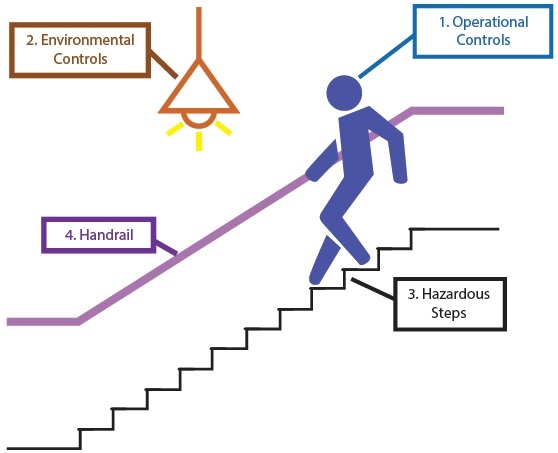
- Every working day one person is hurt in a slip, trip or fall on work stairs or steps
- Descending is associated with many accidents
- Slips are more common (than trips or falls)
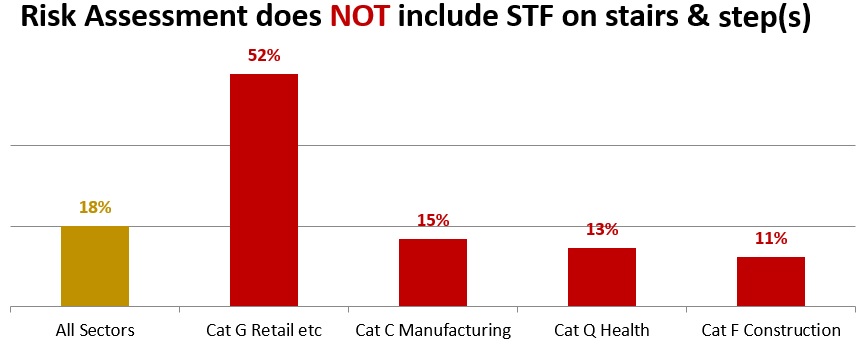
1. Operational Controls
Operational Controls are the rules and policies around the use of stairs and steps. Operational controls are important because " people have a low risk-perception of using the stairs, which causes people to ...perform unsafe behaviours " .
See the Safer Work Stairs and Steps Information Sheet for advice

- Users should remove/replace spectacles if required
2. Environmental Controls
Environmental Controls refer to the visual cues around stairs and steps
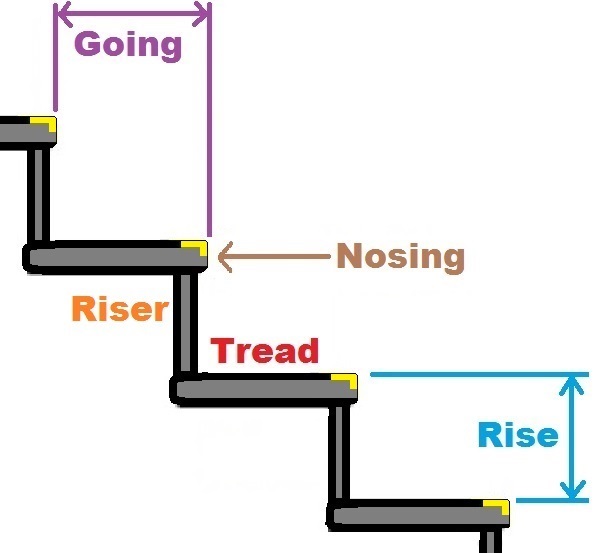
- Provide lighting of at least 100 lux at the tread
- Consider photoluminescent step edges/ nosings and handrails for emergency stairs/ step(s)
- Consider a different-coloured step edge/ nosing at the top and bottom steps for last step confirmation
Visual Contrast and Visual Contrast Checks
Contrasting step edges/nosings and handrails are about lightness or darkness, not colour. Colours that look different may have little visual contrast.
- Check the Light Reflectance Value (LRV) of adjoining surfaces with information from the manufacturer/ supplier. Ensure an LRV difference of at least 30 between adjoining surfaces for visual contrast

- A black and white image can provide a useful indication of the visual contrast
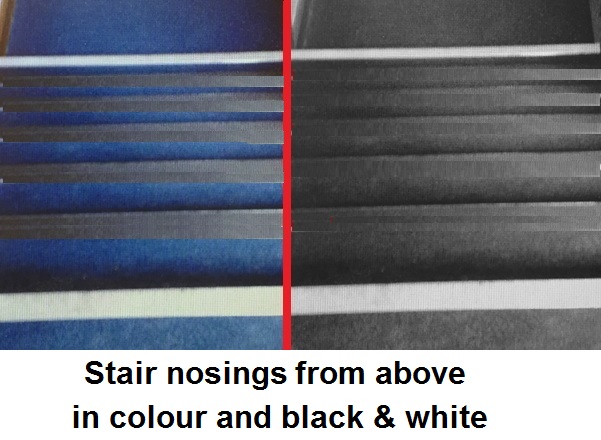
3. Hazardous Steps
There are 4 types of hazardous steps – Slippery, Surprise, Short and Irregular.
a) Slippery Step
A slippery step does not have enough grip , especially at the step edge/nosing.
- Signs should only be used where hazards cannot be avoided or reduced
- On level surfaces, people generally slip on wet surfaces or wet shoes
- On stairs or steps, people could slip if there in inadequate support for the ball of the foot - see Short Steps
b) Surprise Step
A surprise step is not clearly visible or expected. It could be at the bottom of a flight or a single unexpected step.
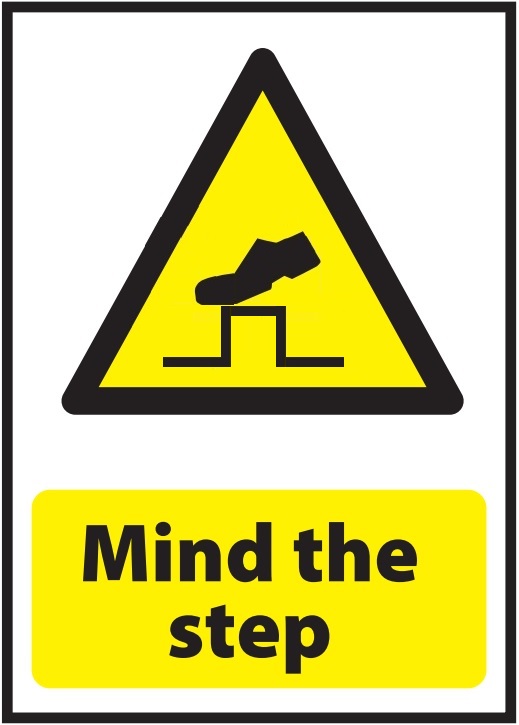
- Signs should only be used where hazards cannot be avoided or reduced
- Marking more than one step with warning stripes could be visually confusing and ineffective
c) Short Step
A short step does not provide adequate support for the ball of the foot for safe forward-facing descent.
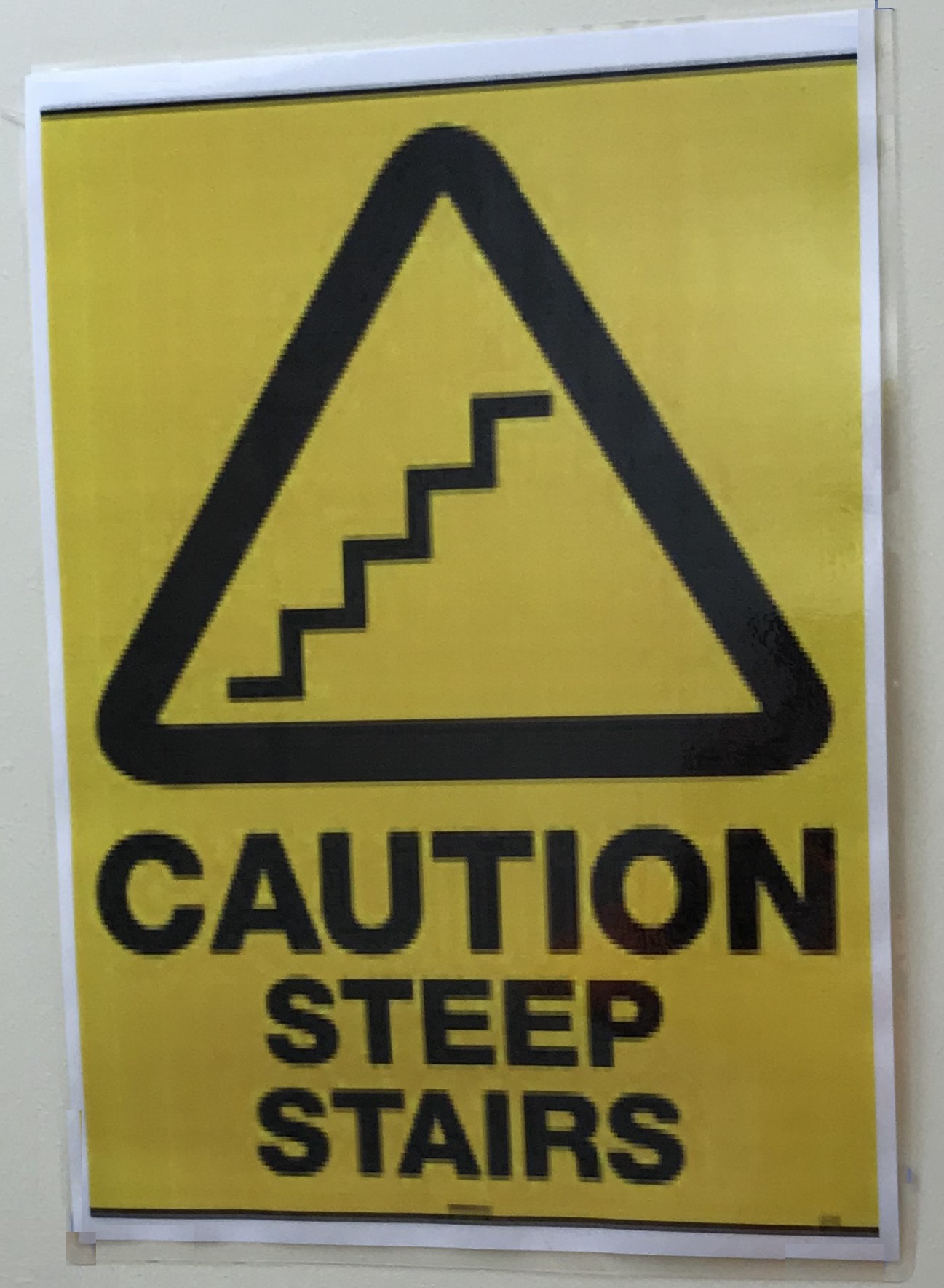
- On 250 mm goings , a large overstep occurs every 10 days
- On 300 mm goings , a large overstep occurs every 73 years
- Building Control Authorities , not the Health and Safety Authority, enforce Building Regulations (including going lengths)
d) Irregular Step
An irregular step is longer or shorter than the other steps in a flight.
- With one 250mm going reduced by 15mm (less than a one cent coin), a large overstep occurs every 2 days
- With one 300mm going reduced by 15mm (less than a one cent coin), a large overstep occurs every 3 years
- Marking more than one step with warning stripes could be visually confusing and ineffective
4. Handrails
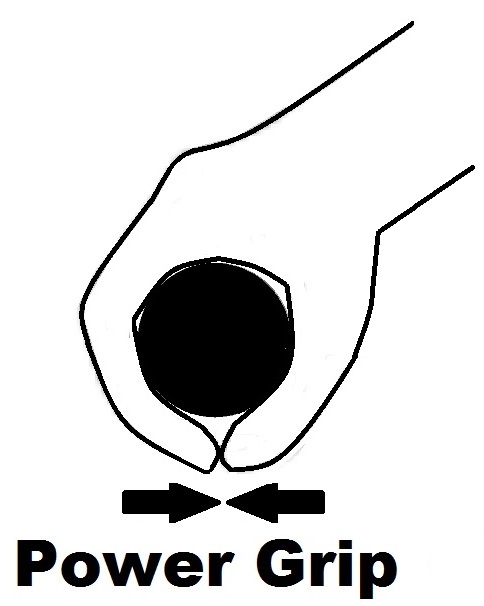
Consider a handrail on the right-hand-side for descent
- Most people are right-handed
When Considering Changes
When considering changes, it may be helpful to edit an image to illustrate proposed changes beforehand

See our 30 minute Safer Stairs and Steps CPD Approved online course
See Stairs, Steps Further Information
See Stairs, Steps Videos
Submission completed, thank you!
Subscribe to hsa publications, subscribe to hsa chemicals publications.

10 Key Stair Safety Tips to Prevent Slips, Trips and Falls
Navigating stairs is an everyday activity that many of us don’t give a second thought. However, stairs can pose significant risks if not approached with caution. Every year, countless individuals experience accidents on staircases, leading to injuries that range from minor bruises to serious fractures or worse. Ensuring the safety of these vertical pathways in our homes, offices, and public spaces is crucial.
In this blog, we will delve into 10 essential stair safety tips that can play a pivotal role in preventing slips, trips, and falls. Whether you’re a homeowner, a business proprietor, or someone who uses stairs regularly, this guide offers invaluable insights to help you tread more safely. Join us as we approach a safer environment, one step at a time.
Common Causes Of Stair Accidents
Stair accidents are unfortunately quite common and can lead to serious injuries. Understanding the most common causes can be essential in prevention. Here are the common causes of stair accidents:
- Poor Lighting: Inadequate lighting can make it difficult for people to see each step clearly, leading to missteps, trips, and falls.
- Uneven Step Sizes: As mentioned earlier, step height or depth inconsistencies can cause individuals to trip or stumble because they disrupt the expected rhythm of climbing or descending.
- Slippery Surfaces: Certain materials can become slippery, especially when wet or polished. This includes surfaces like polished wood, tile, or marble. Even carpeted stairs can be slippery if the carpet is worn down.
- Lack of Handrails: Stairs without handrails or poorly positioned or broken handrails don’t provide the necessary support and can lead to falls.
- Obstructions: Items left on stairs, such as toys, shoes, or other objects, can easily cause someone to trip.
- Worn or Damaged Steps: Over time, stairs can become worn out, leading to uneven surfaces. Broken or damaged steps can be unexpected obstacles.
- Inadequate Visual Cues: Stairs without clear visual indicators (like contrasting step edges) can be hazardous for those with vision issues.
- Distracted Walking: Engaging in activities like texting, reading, or even deep conversation can distract individuals and lead to missteps.
- Improper Footwear: Shoes without proper grip or support, such as high heels or flip-flops, can increase the risk of slipping or tripping.
- Rushing or Not Paying Attention: Hurrying up or down stairs or not being mindful of one’s surroundings is a common cause of stair-related accidents.
- Intoxication or Medication: Being under the influence of alcohol, drugs, or certain medications can impair judgment, balance, and coordination, leading to falls.
- Health Conditions: Certain medical conditions, such as balance disorders, vision problems, or leg weakness, can increase the risk of stair accidents.
Understanding these causes can aid in designing, maintaining, and using stairs to minimize accidents and injuries. Safety should always be prioritized, especially in areas like staircases with heightened potential for harm.

Stair Safety Tips to Prevent Slips, Trips, and Falls
Stairs can be a potential hazard if not navigated with care. Here are 10 key stair safety tips to prevent slips, trips, and falls:
1. Proper Lighting
Proper illumination is paramount for stair safety. When a well-lit staircase, each step is visible, reducing the risk of missteps or trips. Having light switches at the top and bottom of the stairs ensures that users can turn on the light regardless of their starting point, negating the need to navigate the staircase in darkness.
Furthermore, motion-activated lighting can be invaluable in cases where someone might be accessing the staircase during nighttime hours—perhaps when they’re groggy or not fully alert. These lights turn on automatically when movement is detected, instantly illuminating the path. Additionally, nightlights can provide a softer glow that can guide individuals without being overly bright, ensuring that the staircase is never plunged into total darkness, even in the dead of night.
2. Handrails
Handrails are not just an accessory for staircases; they are integral to safety. Individuals often rely on handrails for balance and support when ascending or descending a flight of stairs. When a misstep occurs, a strong and reliable handrail can prevent a minor stumble from turning into a serious fall. These handrails must be sturdy and durable, capable of supporting the weight of an adult in case they need to catch themselves.
Furthermore, a handrail that spans the entire length of the staircase ensures that support is available at every point of the journey. The height of the handrail is also a factor; it should be at a level where it’s easily reachable and offers maximum support.
3. Clear Obstructions
Stairs are meant for walking, not storage. Even small objects can pose significant trip hazards when left on a step. Something as seemingly innocent as a child’s toy, a book, or even a stray shoe can become a dangerous obstacle when someone is unaware of its presence on the staircase.
Consistently keeping stairs clear is straightforward, but it can drastically reduce the risk of accidental trips or falls. Regularly checking and clearing the staircase of obstructions ensures the path remains safe for everyone.

4. Non-Slip Surfaces
Staircase materials vary widely—from wood to tile to carpet and more. While some of these materials naturally offer more grip than others, ensuring that every step provides a stable footing is crucial. Non-slip adhesive strips are a practical solution, especially for steps made from smoother materials that may become slippery, particularly when wet.
These strips can be affixed to the edges of each step, providing additional traction where the foot is most likely to land. Additionally, stair treads—covers made from various materials designed to provide grip—can be laid over each step, further increasing the safety of the staircase.
5. Regular Maintenance
Like any other part of a home or building, staircases are subject to wear and tear. Over time, steps can become worn out, or parts of the staircase can break or become loose. Regularly inspecting the staircase allows for the early identification of potential issues.
Addressing these problems promptly—a loose board, a broken step, or another issue—ensures that the staircase remains in top condition. Regular maintenance is not just about aesthetics; it’s a proactive approach to safety, ensuring that every user can trust each step’s integrity.
6. Uniform Step Size
The design and construction of a staircase play a pivotal role in its safety. Each step should be of consistent height and depth across the entire staircase. This uniformity is crucial because our bodies, particularly our legs, and feet, get accustomed to a specific rhythm when ascending or descending stairs. If there’s an unexpected change in step size, it can easily lead to a misstep or trip.
Inconsistencies can be particularly jarring, disrupting the established rhythm, catching us off-guard and potentially leading to accidents. Therefore, particular attention must be paid during construction or remodeling to ensure that every step is consistent with its counterparts.

7. Visual Contrast
Vision plays a major role in safely navigating stairs. For those with vision impairments or the elderly, differentiating between individual steps can sometimes be challenging. Adding a visual contrast, such as painting the edges of steps with a color that stands out from the main step, can significantly enhance visibility. This contrast acts as a guide, clearly indicating where one step ends and the next begins, which can be particularly beneficial in low-light conditions or for those who struggle with depth perception.
8. Sturdy Footwear
The choice of footwear can significantly influence safety on stairs. Shoes that offer a good grip can prevent slips, especially on surfaces that might be smooth or slick. High heels or shoes with worn-out soles can pose a risk, as they might not offer the necessary stability.
Furthermore, avoiding navigating stairs with just socks on is advisable, especially if the staircase is made of wood or tile. Socks can be surprisingly slippery on these surfaces, and without the additional grip that shoes provide, there’s an increased risk of slipping.
9. Avoid Distractions
Stairs require our attention. Engaging in activities like reading, texting on a mobile phone, or carrying large objects obstructing our view can divert our focus from safely navigating the staircase. When distracted, we’re more likely to miss a step or not notice potential hazards, like an object left on the stairs. Giving stairs our full attention is always advisable, ensuring that we’re aware of our surroundings and reducing the likelihood of accidents.

10. Child and Pet Safety
Staircases can be particularly hazardous for young children and pets, who might not have the same level of coordination or awareness as adults. Installing safety gates at both the top and bottom of stairs is a preventive measure to stop them from accessing the stairs without supervision. These barriers act as a physical deterrent, ensuring that even if a child or pet is curious about the stairs, they can’t easily access them.
Alongside these precautions, educating children about the potential dangers of stairs is crucial. By teaching them the importance of not playing on or near staircases and always using handrails, we can instill safe habits from a young age.
In the hustle and bustle of our daily lives, stair safety might not always be at the forefront of our minds. Yet, the repercussions of overlooking it can be dire. Slips, trips, and falls on staircases account for numerous injuries each year, many of which could be easily prevented by adhering to the essential guidelines we’ve discussed. We can dramatically reduce the risk of accidents by ensuring well-lit staircases, uniform step sizes, and clear paths and educating ourselves and our loved ones about the importance of cautious navigation.
Remember, the staircase is not just a physical structure connecting different levels; it’s a space that demands our attention and respect. Let’s prioritize safety in every step, ensuring that each ascent and descent is as secure as possible. After all, with the right precautions in place, we can ensure that every journey, no matter how short, is safe.
Sidewalk & Walkway Trip Hazards Expert Article
Trips and falls occur when unanticipated variations in walking surfaces interrupt the motions of a pedestrian’s foot. Studies of pedestrian falls have identified that small changes in elevation are particularly dangerous because of the low probability that pedestrians will reliably detect them.
In this article, architect and premises safety expert, Thomas Lodge discusses hazards associated with abrupt changes in walkways such as interior floors and walkway surfaces such as sidewalks and short flight stairs.

Sidewalk & Walkway Trip Hazards
Harvey Cohen and Jake Pauls, in their article “Warnings and Markings for Stairways and Pedestrian Terrain,” have identified that trips are caused by unexpected impediments in a level walking surface and unexpected change in level, and describes:
“Trips and resultant stumbles most often occur during the swing phase of the stride, when the forward motion of the foot is halted unexpectedly. This can be a brief impediment that usually causes a slight, recoverable stumble (where the foot quickly manages to come free), or a longer impediment, where the toe or heel actually becomes caught and a more serious fall results. In both cases, the fall and stumble are almost always forward in motion, and can result in injuries to the hands, elbows, shoulders, head, or knees.” 1
Perception and Visibility of Walkway Trip Hazards
Visual cues in the architecture, site planning, and design of interior and exterior spaces facilitate safe use and enjoyment of the premises by its users. Lack of clarity in visual cues, or any defect in their interpretation or comprehension of the environment, can reduce a person’s ability to understand or to safely navigate the environment; and may cause a hazard to become a dangerous condition. A hazard is a physical condition that may cause harm. A condition becomes dangerous with the likelihood or probability of the hazard being encountered in a manner to cause harm.
When a pedestrian encounters an unexpected obstacle or impediment and does not perceive it in their route of travel, trips and falls occur. An obstacle is unexpected if it is unmarked or provides no other visual cue to alert the pedestrian. The visual field of a walking person is moving and dynamically changing, with only a small part of that field being attended to. Obstacles that fall outside of this small field of view are not perceived unless they are conspicuous and unobstructed. If impediments were marked or expected, the pedestrian likely would perceive the existence of the impediment and take appropriate action to either avoid or safely traverse the condition.
Pedestrians typically scan ahead in the direction of their travel, not directly down in front of their feet. Low elements in the path of travel are not readily identified and are frequent causes of falls resulting in injury. Pedestrians are not likely to see and avoid inconspicuous walkway and sidewalk hazards at or near ground level. If the first identification of a hazard comes when there is an interruption of the gait and loss of balance, a trip and fall may result. Abrupt vertical edges as low as 3/8” have been identified as walkway hazards, and are the cause of falls.

Changes in Walkway Elevation
Walking is easiest and safest on stable, planar, flush, and non-slippery surfaces. Conditions that increase the difficulty of negotiating changes in level while walking, can lead to falls and serious injuries. Floors, patios, sidewalks, parking lots, and pathways are all walking surfaces that must be constructed and maintained without tripping hazards. Standards for safe walkways require that walk surfaces be designed, constructed, and maintained to be safe and free from hazards.
Some examples of sidewalks distresses/deficiencies requiring correction are:
- Heaved slabs, step separation, and paver irregularities. A vertical displacement at any point on the walkway could cause pedestrians to trip.
- Spalled areas and cracked concrete. Fragments of concrete or asphalt separated from the surrounding paving and holes and rough spots could cause pedestrians to trip.
- Settled areas that trap water. Sidewalk segments with depressions, reverse cross slopes, or other indentations may create depressions that trap silt and water on the sidewalk and may reduce the slip resistance of the walking or create tripping hazards.
- Tree root damage. Roots from trees growing in adjacent landscaping that cause the walkway surface to buckle and crack could cause pedestrians to trip.
Hazards of Short Flight Stairs and Single Step Transitions
Single-riser stairs should be avoided where possible. In situations where a short flight stair or single step transition exists or cannot be avoided, obvious visual cues shall be provided to facilitate improved step identification. Handrails, delineated nosing edges, tactile cues, warning signs, contrast in surface colors, and accent lighting are examples of some appropriate warning cues.

Conspicuity of Walkway Hazards
Since pedestrians will assume that walkways do not have hazards, property owners must either eliminate hazards, guard hazards from being encountered by unsuspecting pedestrians, or apply visual cues or other such warnings that make hazards reasonably conspicuous so that their existence may be identified before they are encountered in a manner to cause harm.
Nationally recognized standards for providing safe facilities address visual performance and identify that conspicuity (or the likelihood of a person to identify a potential walkway hazard) is a function of size, contrast, and brightness. The relationship between these critical variables will determine whether a person will reliably identify or recognize an object.
Abrupt changes in walkway elevation that contrast poorly with the surrounding walkway material make it likely to blend in visually with the surrounding environment. An abrupt change in walkway elevation’s ability to be readily identified as a hazard may be improved by applying adequate warnings such as delineated nosing edges, tactile cues, warning signs, or contrast in surface colors. Such warnings may assist pedestrians to identify a dangerous condition that could cause a fall and injury; however, such cues or warnings are not a substitute nor do they negate the need for safe design or construction.
Walkway and Sidewalk Maintenance
For property owners, the standard of care for walkways and sidewalks includes maintaining safe premises and ensuring the protection of pedestrian health, safety, and welfare. The property owner is responsible for ensuring that reasonable periodic inspections are conducted to identify hazards, and correcting those hazards in a prompt manner. When dangerous conditions exist, reasonable efforts should be made to remove them or prevent them from being encountered in a manner that could cause harm.
For nearly 30 years, ASTM F1637 - Standard Practice for Safe Walking Surfaces has been a nationally published and recognized consensus standard that provides minimum maintenance requirements for safe walkways, including exterior walkways and sidewalks. It requires:
- Exterior walkways shall be maintained so as to provide safe walking conditions.
- Exterior walkway conditions that may be considered substandard and in need of repair include conditions in which the pavement is broken, depressed, raised, undermined, slippery, uneven, or cracked to the extent that pieces may be readily removed.
- Exterior walkways shall be repaired or replaced where there is an abrupt variation in elevation between surfaces.
Readily available resources from organizations such as the Building Owners and Managers’ Association (BOMA) and the National Safety Council (NSC) offer property-owners further information and guidance on inspecting and maintaining safe pedestrian walkways.
If a hazardous impediment in a level walking surface is located in a premises’ means of egress, the condition may also be subject to local building and fire codes. Building and fire codes require that floors, walkways, and applicable sidewalks and parking lots in a means of egress be reasonably and continuously maintained free from obstructions or impediments to full instant use in the case of fire or other emergency.
Sidewalk Expert Witness Investigations
The Premises Safety experts at Robson Forensic are frequently retained to investigate cases involving slips, trips, and falls as they relate to floors and walkway surfaces, sidewalks, short flight stairs, gratings, wheel stops, and speed bumps, and other architectural features. Our experts are well versed in the standards relevant to pedestrian safety as well as industry standards governing retail, residential, and commercial premises.
For more information, submit an inquiry or contact the author of this article.
1. Handbook of Warnings , Edited by Michael S. Wogalter, 2006, Lawrence Erlbaum Associates (Mahwah, NJ), p. 712 ↩
Featured Expert

Thomas J. Lodge, AIA, NCARB
Architecture, construction & premises safety expert, short flight stairs: standards and safety, by mark e. williams.
This article addresses some of the relevant standards and safety features used to improve the safety of short flight stairs and single step transitions. Short Flight Stairs & Single Step…
What is a Safe Floor?
By robson forensic.
This article discusses various aspects of flooring relevant to premises liability disputes, including the influence of flooring selection, installation, and maintenance on slip, trip, and fall…
Walking Your Property to Prevent Falls
Falls are the most common and costly accident type for many commercial businesses. In the following article, published in the April 2011 Newsletter for HospitalityLawyer.com, the Premises Safety group…

Home · Blog · Ergonomics : Preventing slips, trips and falls on stairs
Preventing slips, trips and falls on stairs, 10 march, 2021.
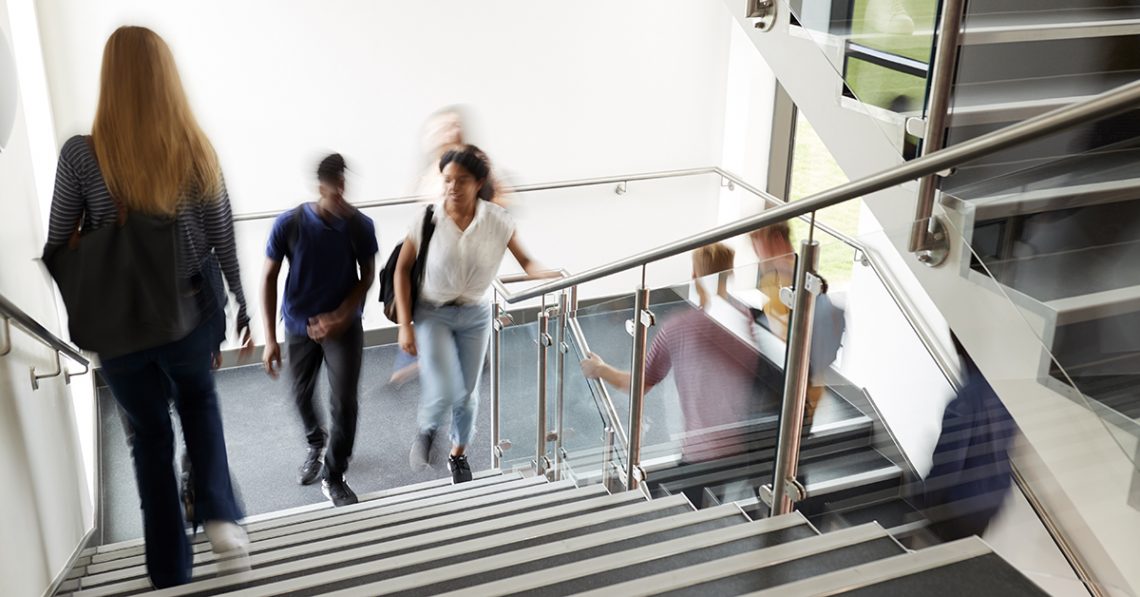
Key points:
• Falls on stairs are common, and often lead to serious injuries.
• Falls on stairs are often complex – there are multiple possible factors that can cause a fall.
• Many stair incidents can easily be prevented, and remedial solutions implemented at minimal cost.
• Ultimately, however, steps and stairs should be designed and built properly, consistent with regulations and common practice, having regard for their purpose and use.
The ubiquitous steps and stairs found in all places of the community present a common fall risk. Each year in Australia, thousands of people are injured in their workplace, home or in a public space due to a fall involving stairs. While most of these injuries are preventable, it remains a fact that such incidents can and do often result in serious injuries or even death.
There are a number of factors that may contribute to a fall on stairs, including design, construction and use. This article will outline some of those factors to look out for when considering the safety of a set of stairs, and suggest practical ways that you can minimise risk of injury.
This advice is necessarily of a general nature only; we recommend that you obtain expert advice if the risk of a fall incident is high. If you are a manager or business owner, it is your legal responsibility to make sure stairs in your workplace are as safe as is reasonably practicable for you to make them.
What commonly causes falls on stairs?
Most falls on stairs occur due to one of the following:
- Slips occur when a person loses traction with the stair surface. The most common causes of slips, therefore, are insufficiently slip-resistant tread surfaces (e.g., surfaces that are highly polished, wet, worn carpet, smooth paint or greasy).
- Tripping occurs when a person unexpectedly catches their foot on part of the stairs. Typically, the objects that a stair user will trip on are small and unobtrusive such as a small lip, or a damaged “nosing” (the step edge). A trip can also occur due to inconsistent step sizing – we rely on uniformity in stairs, and can literally be “tripped up” when it is not provided.
- Mis-stepping occurs when a person oversteps a step or otherwise does not land one of their feet on the next level in the position expected. Our gait (the study of how we walk) is a fragile thing, and it is surprisingly easy to disturb it. Such mis-stepping incidents can often also occur due to dimensional inconsistencies, lack of contrast at the step edges, visual or lighting issues. They can also be caused by damaged steps or poorly maintained steps.
How to minimise slip, trips and falls on stairs
To minimise the risk of a slip or trip and fall on stairs, below are some key things to consider about stair safety, whether it is in a home, workplace or community space.
- Step geometry, the dimension of riser and goings (see diagram below) should be within acceptable limits – the National Construction Code provides a useful table of advice in this regard. “Riser and going” (step rise and run) dimensions should be constant through the flight.
- Is the stairway/stairwell well lit? Long established Australian Standards for lighting provide guidance for a whole host of usage situations.
- Is there good contrast along each the step edge? Is it easy to see that there is a step, and where it’s edge is?
- Is the surface material on the stairs slippery in either wet or dry conditions? Is it exposed to an area likely to get wet or greasy? Is it worn or contaminated with some other material, like powders? Are there surface irregularities? Does it give good traction? Australian Standards for surface slip resistance prescribe minimum requirements for surface coefficients.
- Is the nosing (the front edge of the step, see Figure 1 below) worn, raised and lifted (if there is a strip added) or showing signs of wear? Are there areas where a stair user’s toe or heel could catch?
- Are there handrails? Do they extend the full length of the stairs?
- Avoid single steps where possible – they can hide in plain sight.
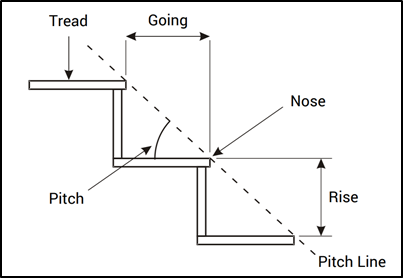
Figure 1 – typical stair properties.
There are other behavioural factors that contribute to falls on stairs, like user fatigue, drug and alcohol use, distraction, carrying heavy or large loads, or sun in the eyes.
As independent safety and ergonomics experts, Dohrmann Consulting have investigated a diverse range of incidents involving stairs, and have also worked extensively with stair designers in ensuring designs meet the appropriate building codes and standards.
We leverage our experience gained from regularly providing expert opinion in stair incidents.
Free ‘Falls on Stairs’ Checklist
We have developed a ‘Falls on Stairs’ checklist that is intended to provide an investigator with guidance as to what to look for and what to ask an injured person when a fall on stairs has occurred. To obtain a copy of this checklist, please click here .
Download Falls on Stairs checklist
You may also be interested in the following information and resources:
- National Construction Code (NCC) Compliance: Expert Safety Advice and Performance Solutions
- Preliminary expert liability advice for legal practitioners
- How to minimise the most common workplace injuries in Australia
Discuss your requirements with an expert – obligation free.
- Like
- Tweet
Related Stories

The Role of Human Factors Specialists in Modern Design.
03 may, 2024.
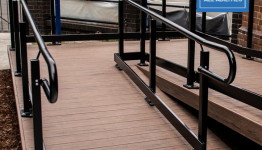
A Guide to achieving Compliance with NCC Performance Requirements.
06 december, 2023.
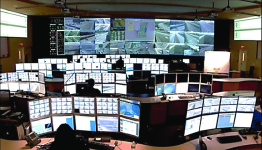
Ergonomic design of Control Centres
27 september, 2023.

Human Factors & Ergonomics in Aviation Maintenance.
13 july, 2023.

Why we do not recommend ‘how to lift’ training.
25 january, 2023.

Engaging a safety specialist to minimise and manage risks.
10 november, 2022.

Mark Dohrmann AM – Appointed a Fellow of Human Factors & Ergonomics Society of Australia (HFESA).
19 october, 2022.
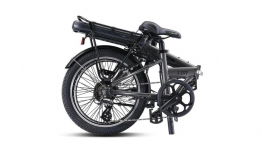
Assessing a product failure: Determining liability
10 october, 2022.

- Search forums
- Welcome to the new and improved Building Code Forum. We appreciate you being here and hope that you are getting the information that you need concerning all codes of the building trades. This is a free forum to the public due to the generosity of the Sawhorses, Corporate Supporters and Supporters who have upgraded their accounts. If you would like to have improved access to the forum please upgrade to Sawhorse by first logging in then clicking here: Upgrades
- Commercial Codes
- Commercial Building Codes
Minimum step height
- Thread starter e hilton
- Start date Sep 27, 2021
Bronze Member
- Sep 27, 2021
Trying to solve an accessibilty issue on a sidewalk, slope is a little too much tor ADA. So we’re looking at creating a landing on the sidewalk with a ramp on one side. Problem is, if the landing is flush with the door threshold and has minimum slope (just enough to drain off rain) the resulting step at 5 ft out is a bit over 2”. Maybe 2-1/2”. IBC 2015. Architect is saying that is not high enough. Where do i find that in the code? I see the max & min step height for stairs … does that apply here?
e hilton said: I see the max & min step height for stairs … does that apply here? Click to expand...
Forum Coordinator
No minimum. See above post.
I'd be nervous that a single step less than 4" would be a tripping hazard. A change of materials or contrasting nosing would alert people to the step and lessen the trip hazard.
jar546 said: No minimum. See above post. Click to expand...
It is part of the exit discharge, especially that close to the building's exterior door. Section 1003.1 (2018 IBC) states that Sections 1003 through 1015 shall apply to all three elements of the means of egress system. Section 1011 is within that group of sections. Therefore, stairs within the exit discharge element must comply with the stair requirements.
Mr. Inspector
If this step is used to go in and out of the building with occupied it must comply with code even if it is outside. If not serving an occupied portion of a building, like a stand alone rest room there is no code for the steps.
The code minimum is not good design, just acceptable legally. I believe research has shown stumbles and falls per use increase below 4 1/2 to 5, just as they begin to increase around 6 1/2. Mainstream the ramp, so everyone uses it. Fewer injuries over the life of the building entrance. If you do the minimum rise, mark the heck out of it, provide a good graspable handrail, and illuminate it if used at night.
Install a handrail to help identify the ramp and landing. As stated might be better to do this and make everyone use it to avoid the step issue.
What is the occupancy? And if we are going to bring in all of Ch 10: 1003.5 Elevation change. Where changes in elevation of less than 12 inches (305 mm) exist in the means of egress, sloped surfaces shall be used. Where the slope is greater than one unit vertical in 20 units horizontal (5-percent slope), ramps complying with Section 1012 shall be used. Where the difference in elevation is 6 inches (152 mm) or less, the ramp shall be equipped with either handrails or floor finish materials that contrast with adjacent floor finish materials. Exceptions: 1. A single step with a maximum riser height of 7 inches (178 mm) is permitted for buildings with occupancies in Groups F, H, R-2, R-3, S and U at exterior doors not required to be accessible by Chapter 11. 2. A stair with a single riser or with two risers and a tread is permitted at locations not required to be accessible by Chapter 11 where the risers and treads comply with Section 1011.5, the minimum depth of the tread is 13 inches (330 mm) and not less than one handrail complying with Section 1014 is provided within 30 inches (762 mm) of the centerline of the normal path of egress travel on the stair. 3. A step is permitted in aisles serving seating that has a difference in elevation less than 12 inches (305 mm) at locations not required to be accessible by Chapter 11, provided that the risers and treads comply with Section 1029.13 and the aisle is provided with a handrail complying with Section 1029.15.
Trying to link a dropbox picture … https://www.dropbox.com/s/fm4zuweye0u0xf4/ENTRY RAMP.pdf?dl=0 Problem is … its a city sidewalk so space is limited. We plan to add a ramp on one side and a handrail on the other side. Trying to avoid a handrail in front of the door.
Won't the ramp require railings with extensions and a curb?
bill1952 said: Won't the ramp require railings with extensions and a curb? Click to expand...
The image you provided changes the whole picture I had in my head. Where does the right-of-way end...at the face of the building? If so, shouldn't it be the responsibility of the jurisdiction to provide accessible means into buildings from the public right-of-way?
Correct, everything outside the face of the building is city property.
Inspector Gift
Sawhorse - made in usa.
I believe RGLA's question is the key to the solution. The design and enforcement rests fully upon the city. IMHO, the proposed solution shown provided in post #11 is NOT an improvement. There are several reasons; not least is the step which must be at least 4 inches high, and the ramp does not have flared sides, or edge protection (curb or barrier). (Please look at ICC A117.1-2017 , Sections 405 and 406 .)
- Sep 28, 2021
Inspector Gift said: I believe RGLA's question is the key to the solution. The design and enforcement rests fully upon the city. IMHO, the proposed solution shown provided in post #11 is NOT an improvement. There are several reasons; not least is the step which must be at least 4 inches high, and the ramp does not have flared sides, or edge protection (curb or barrier). (Please look at ICC A117.1-2017 , Sections 405 and 406 .) Click to expand...
I suggest a ramp up to landing and back down opposite side, parallel to store front, width of landing depth, and a railing along whole thing on street side of ramp and landing. It eliminates multiple trip hazards and creates very minimal sidewalk restrictions and obstructions, and treats everyone equally.
Bill … problem with a ramp on the left is that it is “behind” the door and essentially not useable. Here is a clip from what the architect has roughed out, a couple of important notes: we are creating a bit of a pinch point between the lower left corner of the landing and an existing tree pit, it’s less than 4 ft. And the actual step height will be 3” on the left and 4” on the right. Wonder if we can apply for a variance. https://www.dropbox.com/s/t9pbdbwkzg39l96/Photo Sep 28, 09 18 06.jpg?dl=0
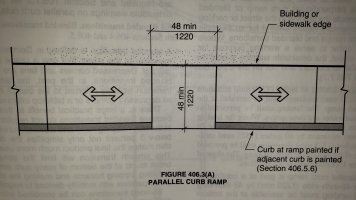
I see people tripping constantly on the brick curb and landing that projects from it, and railing is too far from step to be a useful warning. Gift has best solution, just warp the sidewalk so no railings, steps, ramps, or curbs at all.
Inspector, …that parallel curb ramp works, except the landing height is an inch short., and the city will not make any changes. The best we can hope for is for them to approve and we change at our expense. And actually, …we have a side battle going with the landlord: the lease states its his responsibility, but he is resisting.
bill1952 said: just warp the sidewalk so no railings, steps, ramps, or curbs at all. Click to expand...
Is a straight line from threshold to curb steeper than 2%? Didn't look like it in photo, but can't tell. Yes, it's the whole sidewalk ! The continuous ramp up-landing-ramp down that Gift suggested and similar to what I said seems best of difficult problem, but with a railing. I'm not sure why Gift's landing is 4' from wall rather than 5' - I may be missing something - but at 5' the behind the door issue is minimal., and next, A117.1 I think increases that from 60" to 64 or 66", I'd have to check. Just try not to build in trip hazards like that 6" curb in middle of side walk or 2" landing. Those are certain to cause injuries. There will be orange cones and hasty signs taped to the wall in the first week.

ADVERTISEMENT
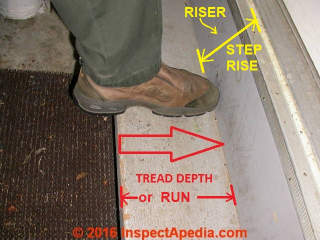
- POST a QUESTION or COMMENT about stair and step riser heights and dimensions and building codes
We also provide a more comprehensive INDEX to RELATED ARTICLES for this topic, but we recommend that you use the page top or bottom SEARCH BOX as a quick way to find information you need.

On 2018-08-01 John R) - Can the top tread of a stair stringer be the same elevation as the finish floor ?
Can the top tread of a stair stringer be the same elevation as the finish floor ?
On 2018-08-01 by (mod That's an interesting question; you're basically extending the floor area by the width of a stair tread, right? Why would you do that? It pushes the whole stairway out by the depth of the stair tread in move that would be unnecessary - but then I can't see your situation, perhaps I'm missing something. I don't think we'll find an explicit prohibition in the stair codes, since the code writers can't and don't try to anticipate every possible variation on what people may invent. But a local building code inspector MIGHT interpret that top tread as a stair top platform. If she does, then the stairs would be improper as the platform would be very much too short. A platform needs to run no less than 3 ft. in the direction of travel up and down the stairs, and yours would run what, maybe 11" - or whatever is your tread depth.
On 2018-06-30 by paula martin - report of a fall at 3-step stair in library

On 2017-12-20 1 by (mod) - Yes 20" as a single step up is too-high a rise and would be a trip hazard. Typically step rise should be around 7"
On 2017-12-19 by Jamrs - help me design a step between two deck surfaces 20" apart
I have two decks at different heights by 20 inches is a step required. ..jd
On 2017-11-25 by (mod) - fine tuning step riser height What's the total adjustment in a 15 step stairway if the total rise really is 104.75" and instead of building steps that each rises 6.98" we instead make each rise 7" and how do we make that adjustment in individual stair riser heights? The total error when we get to the top step is 15 steps x (7" - 6.98") or 15 x 0.02 = 0.3" or 3 / 10 of an inch. The builder could divide the corrective adjustment total rise over three individual stair risers, by making each of the first OR last 3 risers 1/10" shorter than the 7" standard: that is, building the 3 risers at 6.9" and the rest at 7". Having a stair riser that is 1/10" shorter than others in the stairway is a correction of 0.10" per step rise and is thus well below the 0.375" maximum variation allowed in a single step riser. It also makes the math easy for your builder.
On 2017-11-25 by Grant - the last and highest step (the porch/landing) 8.75 inches high - OK?
I am in the process of having an external masonry staircase and porch landing demolished and rebuilt from scratch. At the bottom of this staircase is the sidewalk, and at the top, is the porch that leads directly to my front door.
Or is the riser height discrepancy not that big of a deal? The steps are poured concrete over a deck sheet, supported by 4 metal beams, supported by side walls. Underneath the staircase is hollow. The risers and treads are limestone. Thank you very much for your help.
On 2017-11-25 by (mod) - the last and highest step (the porch/landing) 8.75 inches high - unsafe irregular step riser heights What you describe is not a safe nor acceptable nor Code Compliance stairway. Not only are your risers a bit high but you would have too much variation of the last step. It's more than an issue of Code Compliance and passing a final inspection that's also an issue of people falling and being injured.
On 2017-11-25 by Grant - how do I fix this?
Thank you What can be done from here? Does he have to demolish the staircase and do it again? Is there any other way of correcting it? Demolishing it all and beginning again would be a big job, but I will instruct him to do it if necessary.
On 2017-11-25 by (mod) - how to fix a too-high final step rise Grant I can't make a reliable prescription for a site I know nothing about. But sometimes it's possible to correct an improperly built concrete stairway by increasing the length of the run and then pouring or building new stairs atop what was already there. If you had 13 risers (at 8") and if I GUESS that you had a stair tread depth of 10" and if the stair builder had any sense and made all the steps or treads the same dimensions, then your stair run would be 13 x 10 = 130" or 10.8 feet in the horizontal direction. The ACTUAL stairway, AS BUILT, had a total rise of 12 x 8" + 8.75" (for that "last step) or a total of 104.75" (or I might be missing something as I don't really know your site) Let's GUESS from the above that the total rise of the stairway was that amount: 104.75" over those thirteen unfortunate steps. If you drop the individual step rise to 7" 104.75 / 7 = 14.96 steps to climb that height 7 inches at a time (per step) So we can build a stair with 15 steps. The exact step rise would be 6.98" - so the builder can certainly make that 7" with almost zero adjustment to the individual tread rises and he can certainly keep the step rise uniformity well within spec. Now if we have 15 steps with treads that are 10" deep then our new stair run (horizontal distance) is 15 x 10 = 150" or 12 1/2 feet. If you have room to extend the stair run to 12 1/2 feet you're in good shape.
On 2017-10-09 by Freddy - how do I calculate the number of steps I need to ascend 94 inches
On 2017-10-10 by (mod) - how many stairs do i need in 94" high finish floor? Freddy Let's do a back-of-the-envelope calculation. Assume a 7" riser height. 94/7 = 13.4 risers but since we can't have a fraction of a step, we either increase to 14 risers (giving a step height under 7") or 13 risers (giving a step height just over 7". Let's use 13. 94" total rise / 13 risers = 7.23" individual riser height. In the real world I'd build my steps as 7 1/4" riser height - which would make the entire set of over its 94" rise stairs just 0.26" too tall overall - knowing that I would "lose" 1/8" or less over each of 3 risers or more - within acceptable riser height variation - in order to make the final stairway fit exactly the 94" total rise. Typical codes allow up to 3/8" rise variation among steps. Do not make so much adjustment in a single step riser that you violate code or create a tripping hazard. OR if your local codes prohibit step rises over 7" then go with 14 risers instead of 13. In that case 94" total rise / 14 risers = 6.71" individual riser height for each of 14 risers or steps "up".
On 2017-04-22 by Anonymous - What's the rule say about the height of the landing above the grade?
On 2017-04-22 by (mod) - rule for height of landing above grade If I were your building inspector (which I am not) I would point out that a "landing" that is above grade at its outer end in the direction of travel is in effect a step. Since your step at that point has a 10-inch rise it's too tall. Properly the grade can be brought up to the landing's outer end OR you can build a 5 or 5.5" rise step of appropriate depth (since it's a low rise) down to grade. Put another way, suppose you had to build a "stair" up from grade into your building entry and the total rise were 11" - you would not get away with a single 11" "step" now would you.
On 2017-02-05 by Jane - the steps may be upside down?
On 2017-04-18 by (mod) - ok to make steps of different heights? NO. Jane: What would be upside down? The tread surfaces? You're welcome to use the page top or bottom CONTACT link to send us photos for comment. But NO, do not make steps with such uneven riser height. Even if you become used to the stairs, other people are very likely to trip and fall. Here's an example code citation for stair step height or rise: 2008 NYS Stair Code: R311.5.3.1 - Stair Riser height Requirements. The maximum riser height shall be 8 1/4 inches (209 mm). The riser shall be measured vertically between leading edges of the adjacent treads. The greatest riser height within any flight of stairs shall not exceed the smallest by more than 3/8 inch (9.5 mm.) (Courtesy Arlene Puentes). Stair riser heights shall be 7 inches (178 mm) maximum and 4 inches (102 mm) minimum. Stair tread depths shall be 11 inches (279 mm) minimum. The riser height shall be measured vertically between the leading edges of adjacent treads. For a 17.5" total rise height, I would figure the number of steps and riser height by finding a number close to 7" that will divide into 17.5" 3 times - thats because if I divided the height evenly in half your two steps would be 8 1/4" which is a bit tall (though your building inspector might accept those) So let's divide 17.5 / 3 step risers = 5.8" rise height. So your choices are 3 steps 5.8" high (those will want a deeper tread, say 13-14") or 2 steps that are a bit tall at 8.5" = subject to building department approval. At https://inspectapedia.com/Stairs/Stair_Calculations.php you will find this subtopic CALCULATE STEP TREAD DEPTH https://inspectapedia.com/Stairs/Stair_Calculations.php#CalcTreads that talks about that dimension. Generally when we shorten the rise height below about 6" we need to make the tread depth greater to avoid a trip hazard. More details about stair tread dimensions including a discussion of tread depth is at https://inspectapedia.com/Stairs/Stair_Tread_Dimensions.php - STAIR TREAD DIMENSIONS where we discuss the requirements for uniformity in stair height and depth and slope
On 2017-01-11 by Anonymous - what's the right height for the last step down to the lower floor?
On 2017-01-11 by (mod) - ALL of the steps in a flight of stairs should be the same height Anon ALL of the steps in a flight of stairs should be the same height. Otherwise the steps are a trip-fall hazard. Don't make your last, or first nor any other steps vary . - no step riser height variation from one step to another that is greater than 0.375 inches is acceptable
On 2016-06-15 by Mr T - There is no variances allowed for open risers.
On 2016-06-15 by (mod) - variances allowed for open risers Mr. T thanks for the comments but we're stumped - don't know what photo you refer to. If you mean the photo of the tall rise steps to a deck with client showing the rise with a tape, "upside down" or not won't change the too-deep notch cuts that give almost no stringer strength - less than a 2x4 - nor the too-tall rise for this stair access from ground to deck.
On 2015-11-19 by Tom - In NY state what is the concrete riser height code for new walkways
On 2015-11-19 by (mod) - Walkways, i.e. sidewalks, are not stairs. Sorry I don't quite understand the question. Walkways, i.e. sidewalks, are not stairs. I would agree with the OPINION that if the edge of a walkway also functions as a step up from a lower level, at that point you'd want to respect the maximum stair riser heights discussed in the article above.
On 2015-11-12 by Anita Chapman - one step is 7" and the other 10"
On 2015-11-12 by (mod) - uneven steps are a trip hazard Anita I agree that uneven steps are a trip hazard; The best solution builds steps that are not too tall (10" is too tall) but the problem we're going to encounter - maybe - is how much horizontal space you have in the direction of travel. Let's design a stair for the total rise you cite: Divide the total rise by 2 and your steps are over 8" and too tall. so Divide by 3: 17/3 = 5.6" - that's the rise you need to build, using 3 steps. Now because that's a rather low step, you'll want to increase the tread depth - the distance from the step nose to the face of the vertical riser board. I'd want my steps to be at lesat 12" deep - so we need 36" or more in the direction of travel. If you can fit that you're in good shape.
Reply: no stair step riser height variation greater than 0.375 inches is allowed Dan, There is no exception for individual stair steps, first, bottom, top, or other. A difference in riser height can be a serious trip hazard at any location on a stairway. Quoting from the article text above on stair and step height regularity and the amount of variation in stair step riser height that is allowed (presumably to avoid a trip hazard) "Stair risers of uneven height - no variation greater than 0.375 inches is allowed"
Minor Adjustments can fit a factory-built stair to the specific overall stair rise
Reply: Here is a simple approach to calculating the stair rise & run for a low slope stairway Great question. Bernie Campbalik who taught us carpentry, including stair building, used a rule of thumb that basically makes the run longer when the rise is shorter. I've seen several rules such as the sum of one tread and one riser should always be equal or greater than 17; I think we need to dig out some texts on stair design such as those in the references. The concept is that a low rise stair usually has, just as you suggest, a tread that provides a "longer" walking surface. Up to a point. If we make the rise too short, say an inch, it's not a step at all, it's a trip hazard. See details at STAIR BUILDING RULES of THUMB
Reply: stair design basics: calculating step riser height, step tread depth, total rise, total run, intermediate platform lengths Tom, I think a sketch of what you're up to would be helpful - if you want to send one use the CONTACT US link at page top/bottom. Meanwhile I'll provide two of my own: a "theoretical stairway" and then the "actual calculated stairway" at the end of these notes, based on the figures you provided. Please see the details about how to calculate step or stair rise & run over at Stair Rise & Run Calculations where we discuss this topic nearly to death.
On 2014-06-02 by K. - steps or rails between rooms with floors at different heights ?
What about two rooms that are at different heights, so there is a single "step" up about 4". Any requirements for safety?
On 2014-06-02 - by (mod) - K. You want visual cues to call attention to the step, such as color differences on the two floors and perhaps a color difference on the face of the riser.m. That's my opinion, not a code citation.
On 2014-05-25 by [email protected] - can first step be smaller in height ?
can first step be smaller in height than the balance of the stairs (nj building codes)
On 2014-05-27 - by (mod) - Sinees NO - variation more than 0.375 inches ibetween successive stepr riser heights would be a trip and fall hazard.
On 2014-02-21 by isibro o ochoa - how fast does a body fall when falling down stairs?
my question is how fast would i be going before i hit the floor if i fell down a stairway approximatly four steps to the bottom which would be 32 inches.and land on my shoulder
On 2014-02-23 - by (mod) - Isibro, that's an interesting question and I have no doubt that an attorney can find someone who will come up with a calculated number based on simple physics and terminal velocity but IMO the number would be rather unreliable considering that there are some most liklely unknown but important factors involved: whether or not a person attempted to interrupt a fall, directions of movement: forward vs vertical, actual distances between the person's shoulder at the start of the fall and the end of the fall - which is almost certainly not the simple step height. One also must know how far the person (or shoulder traveled AFTER the point of impact. You can hop over to a physics site where many of them give a nice online calculator for "Impact Force from Falling Object" if theory rather than actual impact force is what's of interest. It's not the approach I would take.
Continue reading at STAIR RISER SPECIFICATIONS or select a topic from the closely-related articles below, or see the complete ARTICLE INDEX .
Recommended Articles
- STAIR RISE & RUN CALCULATIONS
- STAIR DIMENSIONS, WIDTH, HEIGHT
- STAIR CODES & STANDARDS - home
- STAIR CODE DETAILS
- STAIRS, RAILINGS, LANDINGS, RAMPS - INSPECTIONS, CODES .
- Or see the ARTICLE INDEX below for detailed articles on specifications for proper dimensions for stairs, railings, platforms
Or see this
INDEX to RELATED ARTICLES: ARTICLE INDEX to STAIRS RAILINGS LANDINGS RAMPS
Or use the SEARCH BOX found below to Ask a Question or Search InspectApedia
Note: appearance of your Comment below may be delayed: if your comment contains an image, photograph, web link, or text that looks to the software as if it might be a web link, your posting will appear after it has been approved by a moderator . Apologies for the delay.
Only one image can be added per comment but you can post as many comments, and therefore images, as you like. You will not receive a notification when a response to your question has been posted. Please bookmark this page to make it easy for you to check back for our response. Our Comment Box is provided by Countable Web Productions countable.ca
- In addition to citations & references found in this article, see the research citations given at the end of the related articles found at our suggested CONTINUE READING or RECOMMENDED ARTICLES .
- Carson, Dunlop & Associates Ltd., 120 Carlton Street Suite 407, Toronto ON M5A 4K2. Tel: (416) 964-9415 1-800-268-7070 Email: [email protected] . Alan Carson is a past president of ASHI, the American Society of Home Inspectors. Thanks to Alan Carson and Bob Dunlop, for permission for InspectAPedia to use text excerpts from The HOME REFERENCE BOOK - the Encyclopedia of Homes and to use illustrations from The ILLUSTRATED HOME . Carson Dunlop Associates provides extensive home inspection education and report writing material. In gratitude we provide links to tsome Carson Dunlop Associates products and services.

IMAGES
VIDEO
COMMENTS
That means preventing slips, trips, and falls is an ongoing process that relies heavily on employees being able to recognize related hazards. What Are OSHA's Trip Hazard Regulations? OSHA's primary standard for slip, trip, and fall hazards is the General Industry Walking-Working Surface standard (29 CFR 1910 Subpart D, which includes §1910.21-30).
More than 3/8 of an inch in variation of the height of steps from one step to another is a tripping hazard recognized in virtually all model stair codes. See STAIR RISER SPECIFICATIONS for details about proper step riser height and riser uniformity requirements. Uneven Step Surface & Other Stair Hazards. The steps shown at above (Spain) were ...
Addition of a sloping handrail within 30" of the pedestrian's path helps provide a visual cue of a descent. Replace the single riser with a ramp. Attorney Jeff "JJ" Shaw has been handling single riser and short flight stair trip and fall cases for decades. Call or Text (260) 777-7777 to get Attorney Shaw working on your case within 10 ...
Hazards in the Workplace. In 2022, 865 workers died in falls, and hundreds of thousands were injured badly enough to require days off of work. A worker doesn't have fall from a high level to suffer fatal injuries; 144 workers were killed in falls on the same level in 2022, according to Injury Facts. Construction workers are most at risk for ...
deaths overall in the U.S. and the number one cause of death for those 68 and older, according to Injury Facts® (injuryfacts.nsc.org). How to Prevent Falls Take these simple steps to prevent falls both at home and in your community: • Remove clutter, including electrical cords and other tripping hazards, from walkways, stairs and doorways
1. Mark the step rises starting from the bottom step on a sheet of A4 paper. 2. Compare the markings to see if there is a difference in step dimensions. If a difference is noticed, measure the rises and goings with a ruler. 2. Check all the steps for differences 1. Mark the rise and going of the step using a piece of paper
Commonly found inside public buildings such as hotels and restaurants, "air step" falls occur because people fail to perceive the modest change in floor level and are usually the most serious accidents on low stairways. Tripping also is a hazard, especially when people don't notice the stairway as they approach from the lower level.
By Gian Joseph, Safety Advisor. As we enter the rainy and cold season, we face several risks, which include slips, trips, and fall s in our day-to-day activities. It is important t o be aware of hazards around us and learn how to properly identify and assess any risks with each step.. Slips, trips, and falls (STFs) are common accidents that can lead to severe injuries.
Trip Hazards. A trip simply is when a foot that is moving forward suddenly confronts an unexpected obstacle or resistance. We understand, I hope, the elevated trip hazards that a single rise in walking surface, a single step, creates, because tripping against a single step has a exponentially greater risk than a set of stairs.
recognize fall hazards to prevent injuries from occurring. View the world from a safety lens The truth is that hazards are all around us. Sometimes it is difficult to see them, especially when we are working in familiar conditions. Instead of going through our usual routines, we should always stay vigilant and keep an eye out for safety. It
are free from trip hazards or obstacles. If patients or residents lack mobility and require extra support, then the stairs should have suitable handrails on both sides. ... the leading edge of the step should be marked to improve contrast between the step and edge. These features make the stairs safer for all users, including staff. Wherever ...
Sunday, August 5, 2018. A single step up or down in a home may be familiar to the homeowner, but is often a surprise to a visitor. When there is just one step, it often lacks the visual cues that stairs provide, such as a railing and clearly defined, significant change in level. We encountered an extreme example of a dangerous single step ...
Safer Work Stairs and Steps. Our 30 minute Safer Stairs and Steps online course, CPD Approved, provides advice on the key hazards, including four types of hazardous step and provides advice on the four holistic elements of safer stairs and steps.It provides practical checks for the workplace like the crouch-and-sight test, the foot fit test, visual contrast checks and the step check.
Stairs can be a potential hazard if not navigated with care. Here are 10 key stair safety tips to prevent slips, trips, and falls: 1. Proper Lighting. Proper illumination is paramount for stair safety. When a well-lit staircase, each step is visible, reducing the risk of missteps or trips.
More than one control measure may be needed to provide the best protection. A checklist to assist with the identification of slip and trip hazards and the selection of appropriate control measures is on page 7 of this fact sheet. Identifying slip and trip hazards Common slip hazards include: • spills of liquid or solid material
Sidewalk & Walkway Trip Hazards. Expert Article. Trips and falls occur when unanticipated variations in walking surfaces interrupt the motions of a pedestrian's foot. Studies of pedestrian falls have identified that small changes in elevation are particularly dangerous because of the low probability that pedestrians will reliably detect them.
A trip can also occur due to inconsistent step sizing - we rely on uniformity in stairs, and can literally be "tripped up" when it is not provided. Mis-stepping occurs when a person oversteps a step or otherwise does not land one of their feet on the next level in the position expected. Our gait (the study of how we walk) is a fragile ...
Slip and trip accidents happen for a number of reasons. The following model will help you understand the factors that can contribute to slip accidents and the action to take to prevent them . It is called the slip potential model. One or more of these factors may play a part in any slip accident. Slip potential model. Slip potential model
I'd be nervous that a single step less than 4" would be a tripping hazard. A change of materials or contrasting nosing would alert people to the step and lessen the trip hazard. Reactions: Inspector Gift. e hilton Bronze Member. Joined Jul 2, 2014 Messages 3,159 Location Virginia. Sep 27, 2021 #5
I apologize if the photo was confusing and I'll review our text. It is the case that included not far below the photo is the following: "Step riser height uniformity (<= 3/8" variation) - this means that more than 3/8 of an inch in variation of the height of steps from one step to another is a tripping hazard." On 2021-07-18 by Kade Soprano
Yes 20" as a single step up is too-high a rise and would be a trip hazard. Typically step rise should be around 7" On 2017-12-19 by Jamrs - help me design a step between two deck surfaces 20" apart. I have two decks at different heights by 20 inches is a step required. ..jd. On 2017-11-25 by (mod) - fine tuning step riser height
The law The Health and Safety at Work etc Act 1974 (HSWA) The Health and Safety at Work Act 1974 requires employers to ensure the health and safety of all employees and anyone affected by their work, so far as is reasonably practicable, which means balancing the level of risk against the measures needed to control the risk in terms of money, time or trouble.
person can trip and fall. One strategy for reducing trip hazards caused by raised portions of sidewalks or other walkways is to grind down the raised edge. Raised concrete, pavers, and bricks create a trip hazard. Tree roots can raise sidewalks and walkways when a tree is planted too close. BeFoRe: Raised sidewalks create a trip hazard.